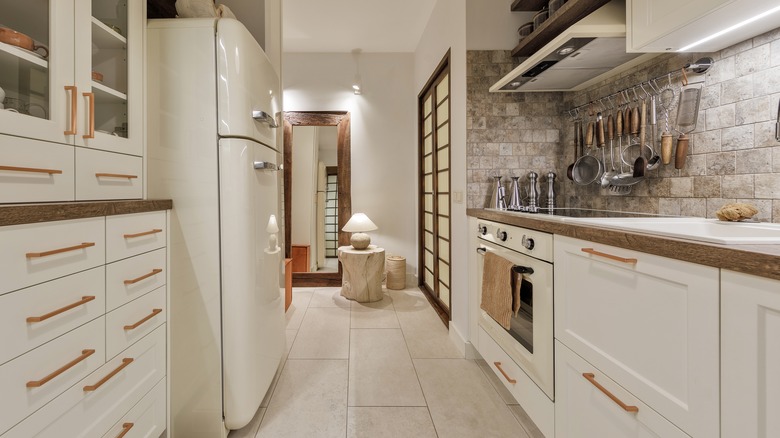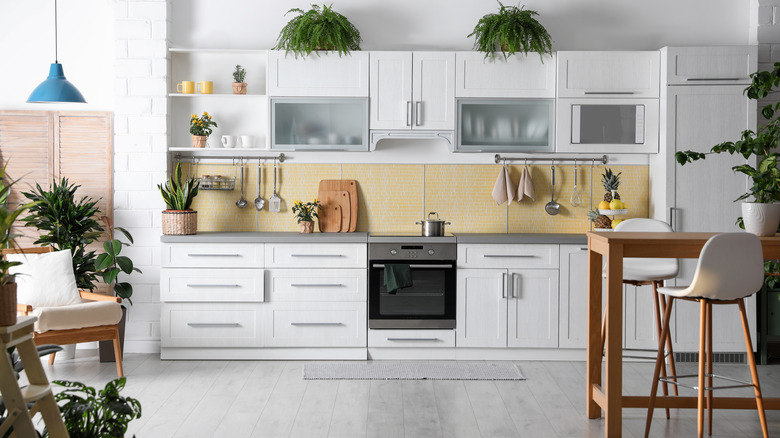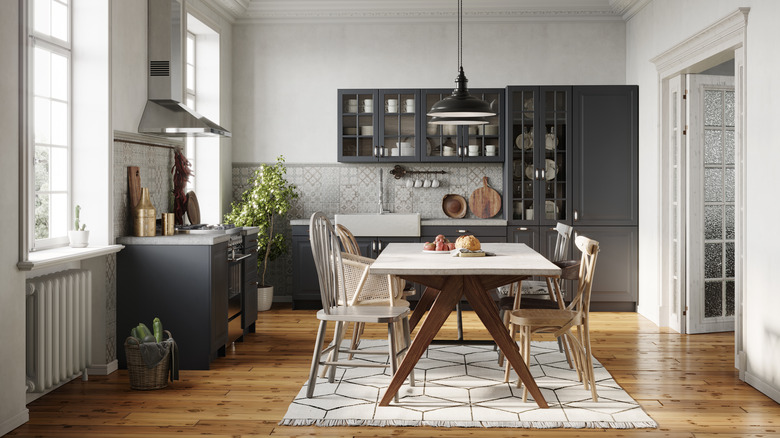Simple Additions That Bring A Cozy Japandi Style To Your Kitchen
What do you get when you try to strike a balance between Japanese and Scandinavian interior design? The Japandi style, of course. It meets at the intersection of both, highlighting the characteristics they have in common like minimalism, nature, simplicity, and warmth. In the kitchen, Japandi style focuses on these features and expresses them through natural, muted colors, materials, and textures.
The appeal of the Japandi style is just like that of its parent aesthetics. People love the strong connection to nature and how that is achieved through basic elements like neutral colors and organic materials. Japandi décor also feels timeless instead of transient, while leaving room to incorporate trends, provided they fit the softly minimalistic bill. A guide to using Japandi style in your home is to keep things simple, sustainable, and to create a serene environment. This may feel challenging in a kitchen, where you might be faced with gleaming, modern stainless steel appliances, or traditional-style cabinetry. But by adding the right décor, (such as rattan barstools, a jute rug, or neutral pottery items) incorporating lots of soft wood tones, and corralling clutter — you can still achieve a Japandi design in your space.
Bring in nature
Both Japanese and Scandinavian interior design prioritize the presence of organic elements. In a Japandi-style kitchen, this will look like surfaces and accessories made of genuine materials, houseplants for decoration, and an abundance of natural light. Natural stone and wood (no paint required) can be used for cabinets, counters, and dining table sets, while rattan and wicker are ideal for things like storage baskets. Bonus points if any of these are handmade or crafted by artisans. Storage baskets can be ideal for housing miscellaneous kitchen items that you don't want on display and which would take away from the simple, pared back look you're trying to create.
Besides lush green plants, dried branches can also serve as decorative accents. They can make the kitchen feel like an extension of the outdoors, creating that sense of seamless connection with nature that underpins Japandi designs. Your color palette is another major factor. To bring a cozy Japandi style to your kitchen, colors should mimic soft, muted tones found in nature, so the eye feels ultra relaxed. A common color palette includes warm whites, beiges, browns, and some grays, with black accents tossed in for contrast. For more color, you can add soft, muted greens and yellows.
Layering and textures
In addition to neutral colors, Japandi design typically features lots of texture that adds to the visual interest of the scene. You can leave your wood tables or chairs unsanded, display plants with textured leaves like nerve or peacock plants, and use a hanging branch as a storage rod. These rough textures, combined with plain, smooth appliances and plate sets, will create contrast in the space. Also go for jute, wool, or linen when buying napkins, rugs, placemats, table runners, and other accessories. They will look and feel cozy, add subtle texture, and pair harmoniously with other organic elements in the space.
Your light fixtures can also play a role in creating a cozy Japandi kitchen. Choose bamboo or other textured lampshades in natural materials, or mix and match different shapes and sizes around the room to achieve a layered lighting plan. This is a particularly clever strategy if your kitchen doesn't receive much natural light. You could also incorporate macramé into your space in the form of wall art or plant holders. It's a great way to add something handmade and can also make for a fun DIY project. Overall, Japandi is a perfectly imperfect décor style, so there's no need to chase a flawless end result. Instead, embrace your space, minimize clutter, incorporate serene, soft, and natural materials — and you'll start to see that Japandi vibe take form.


